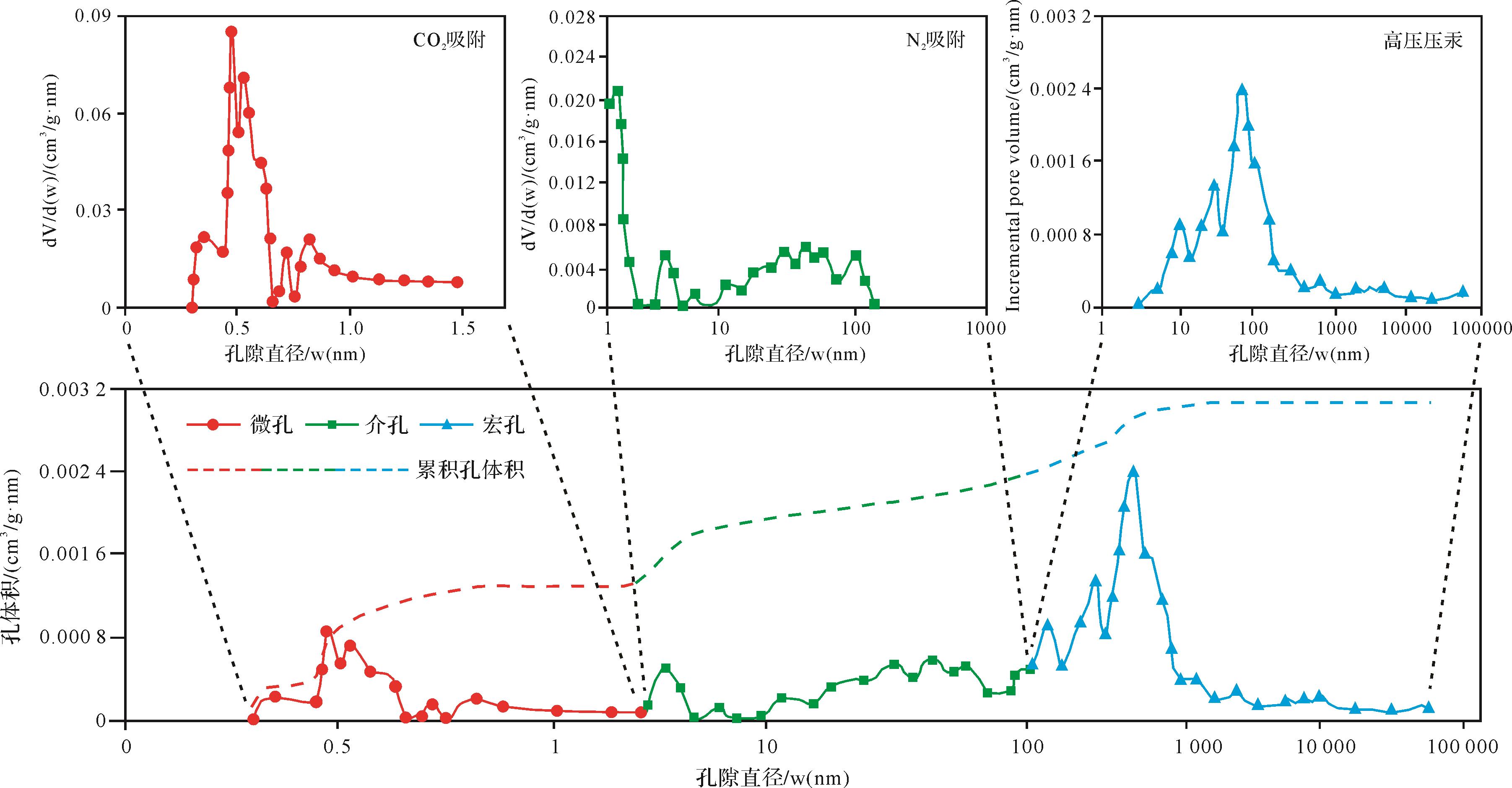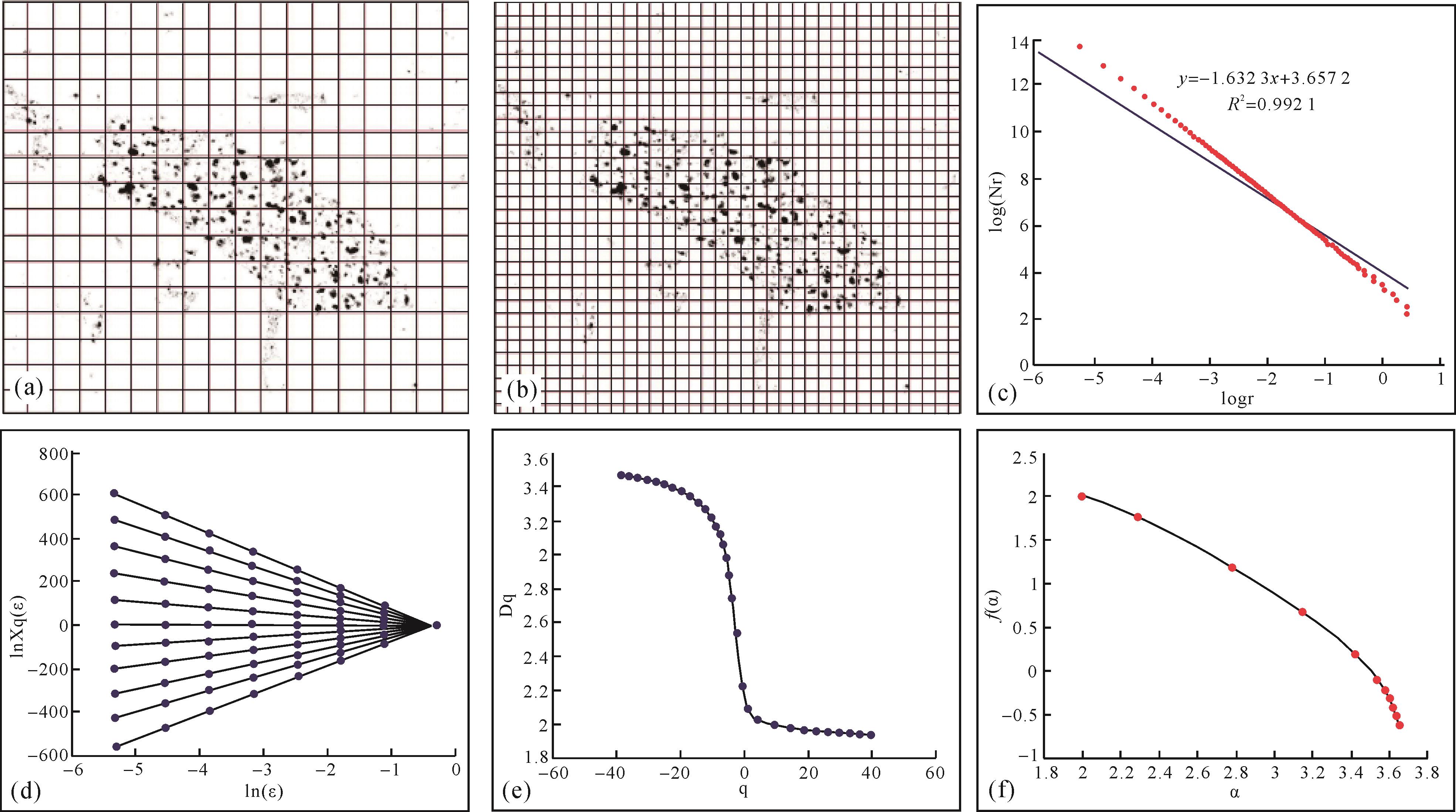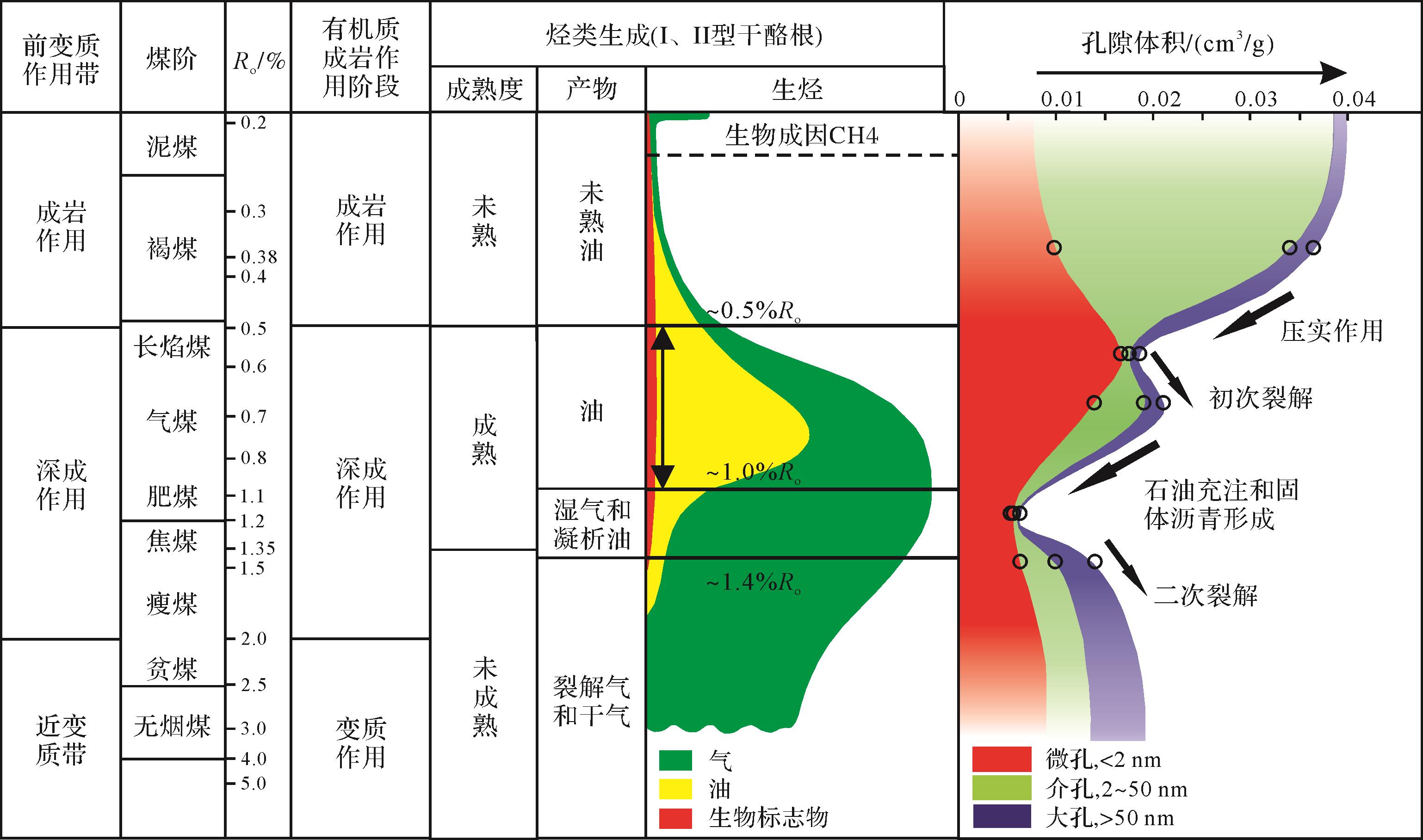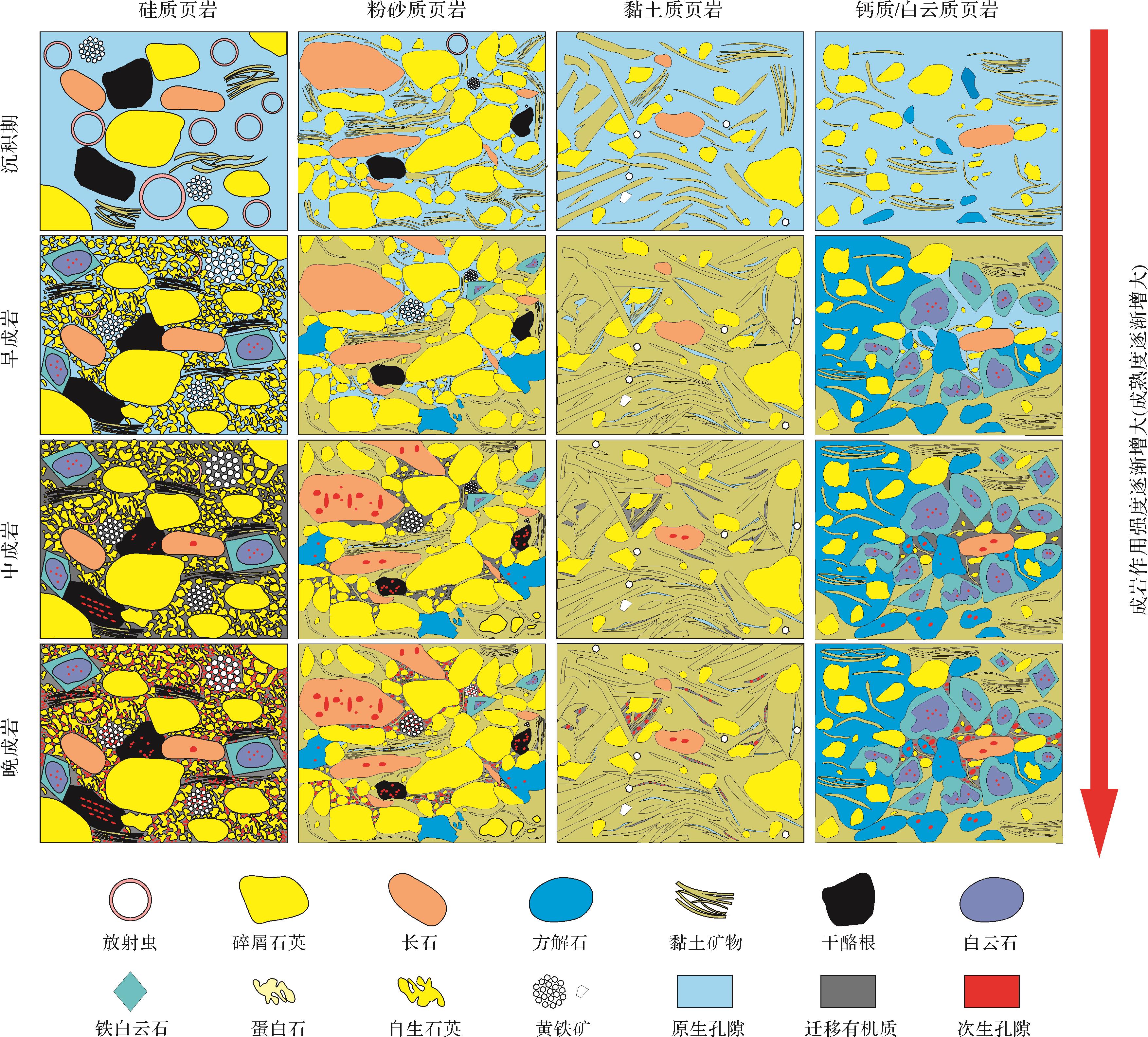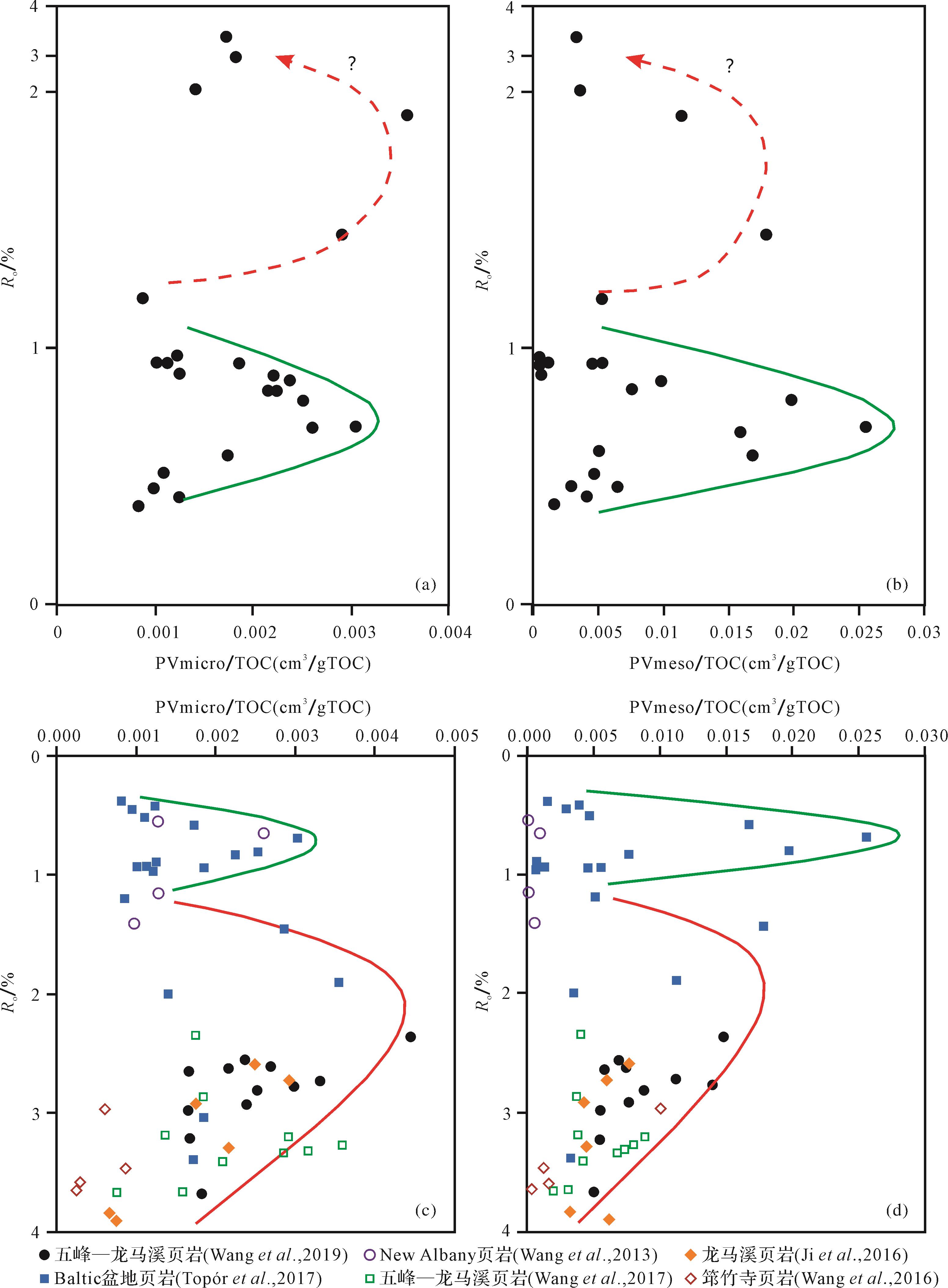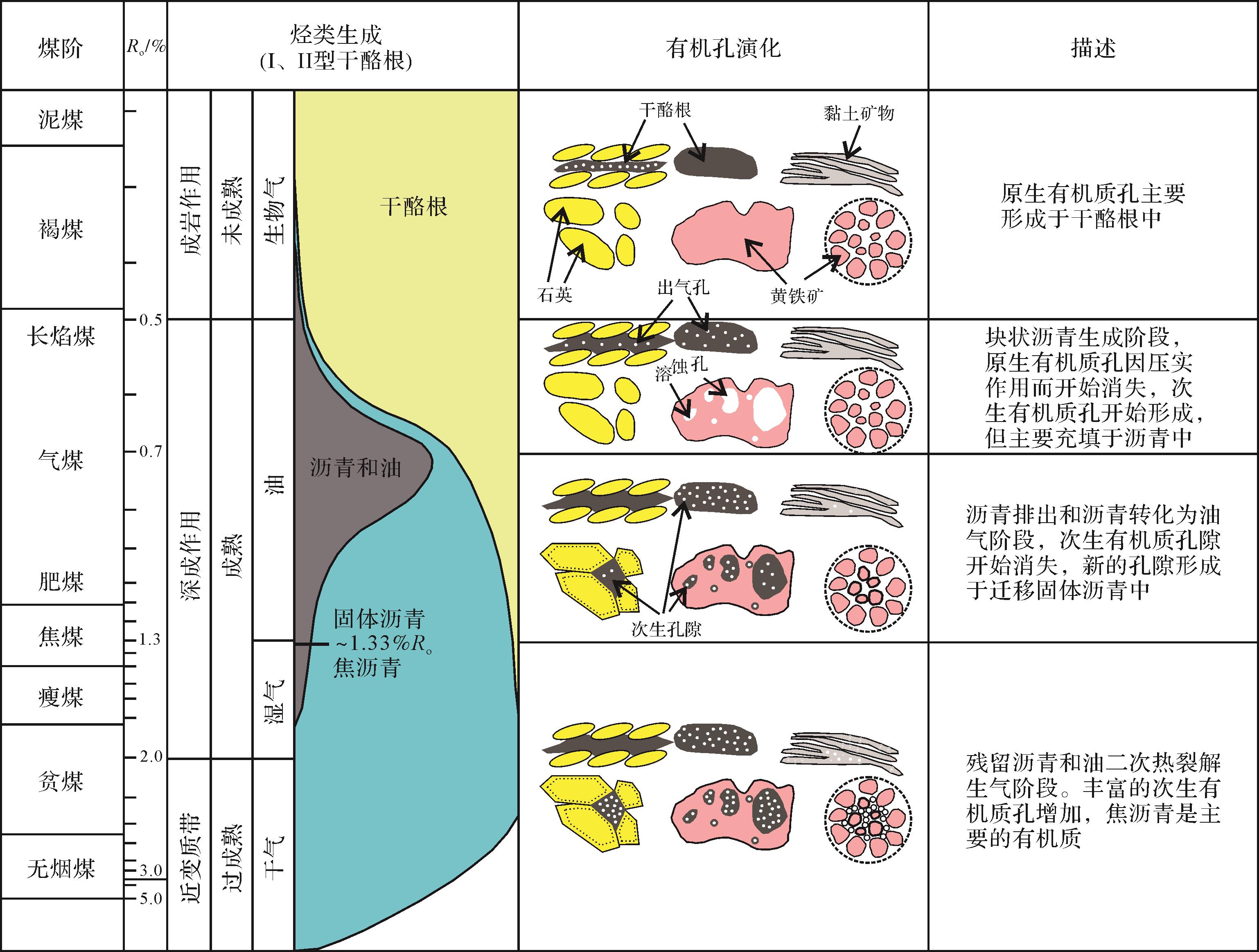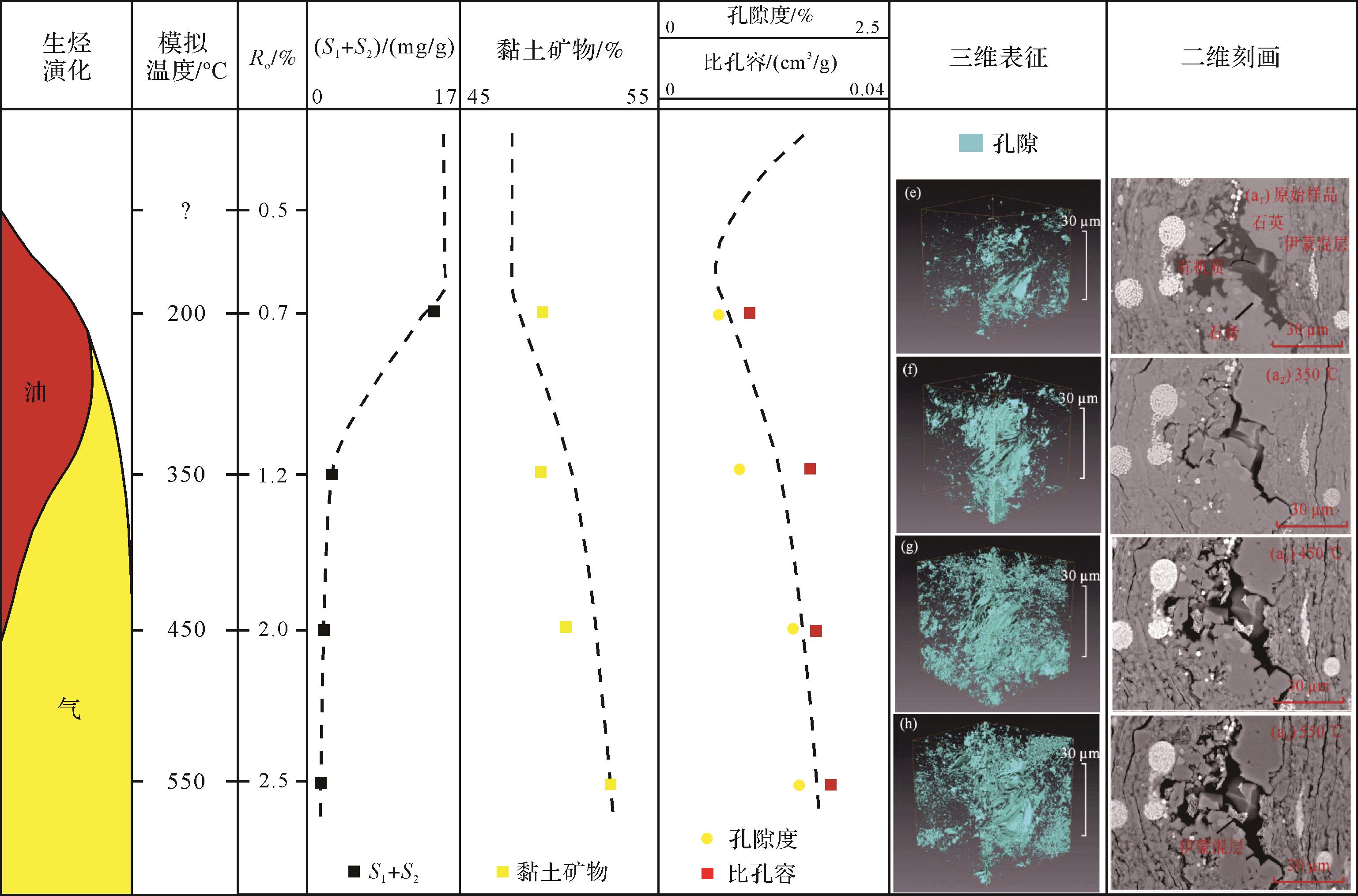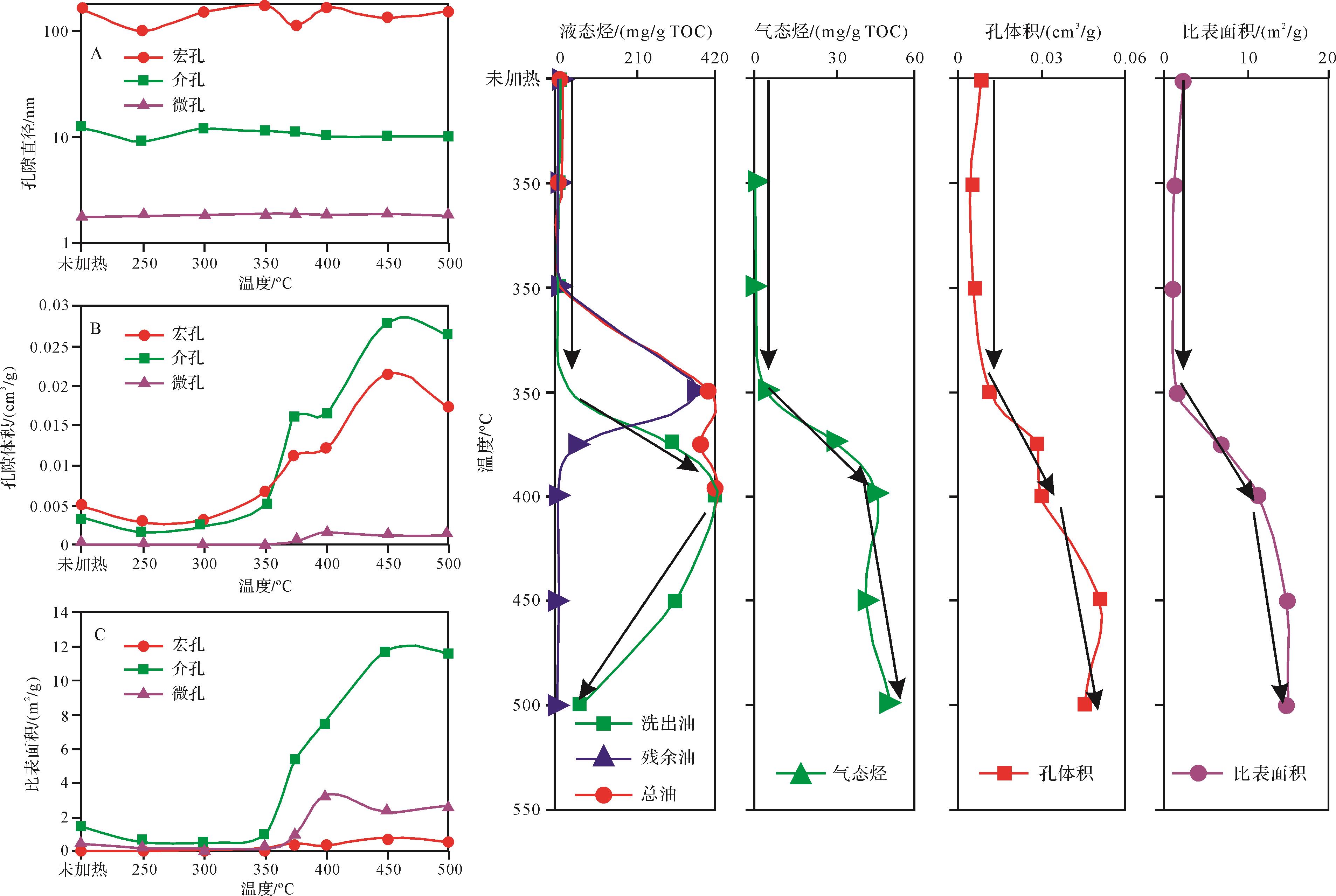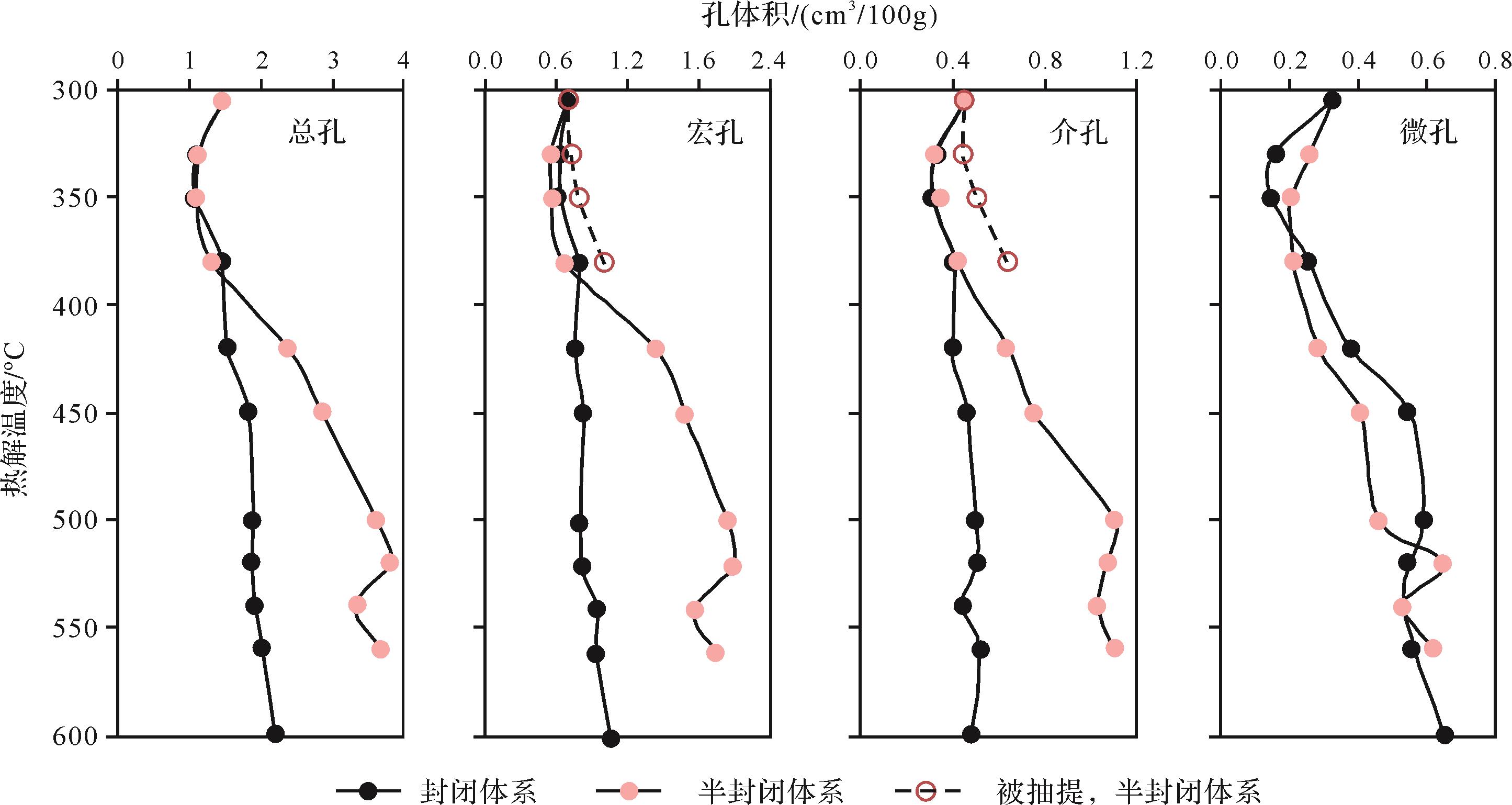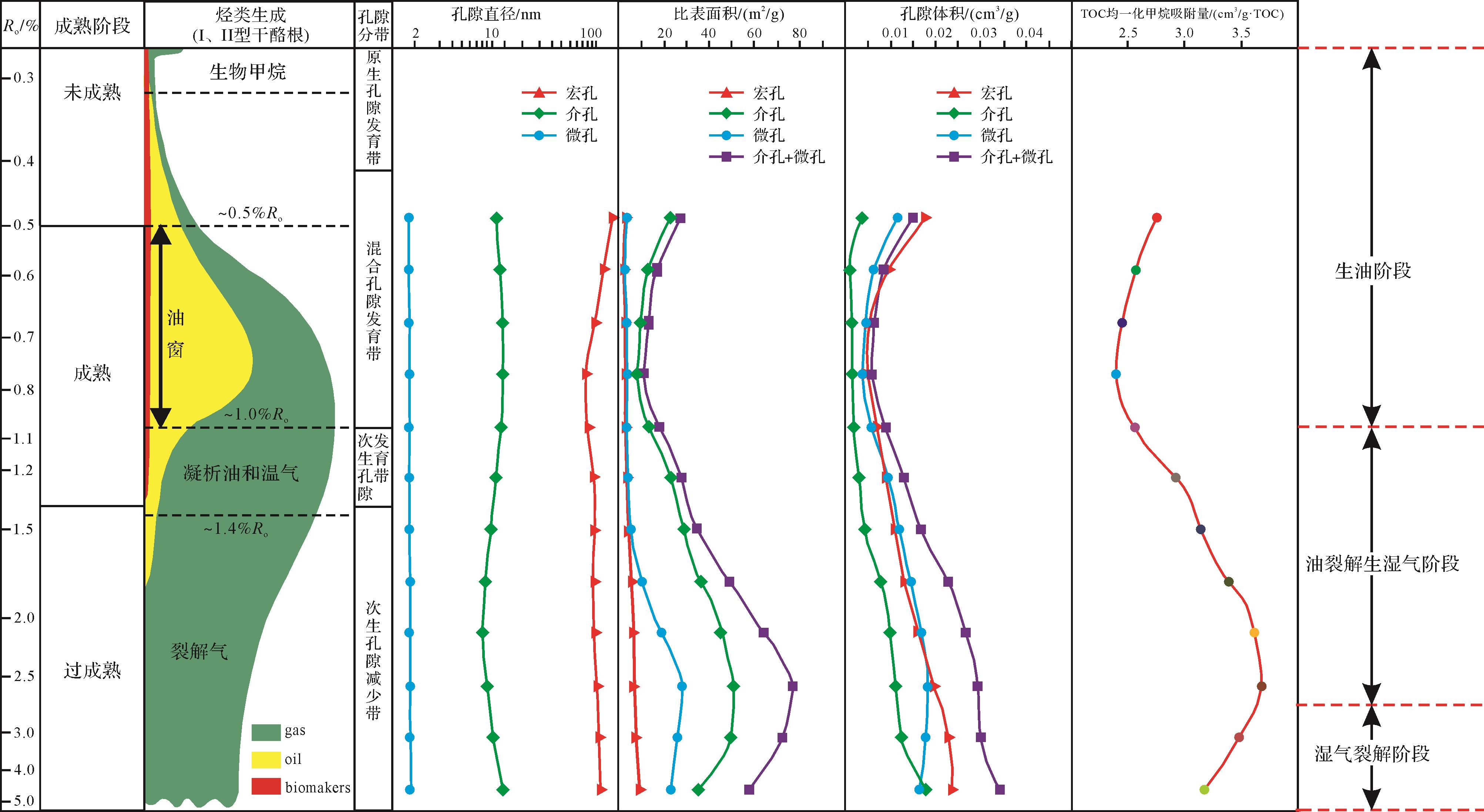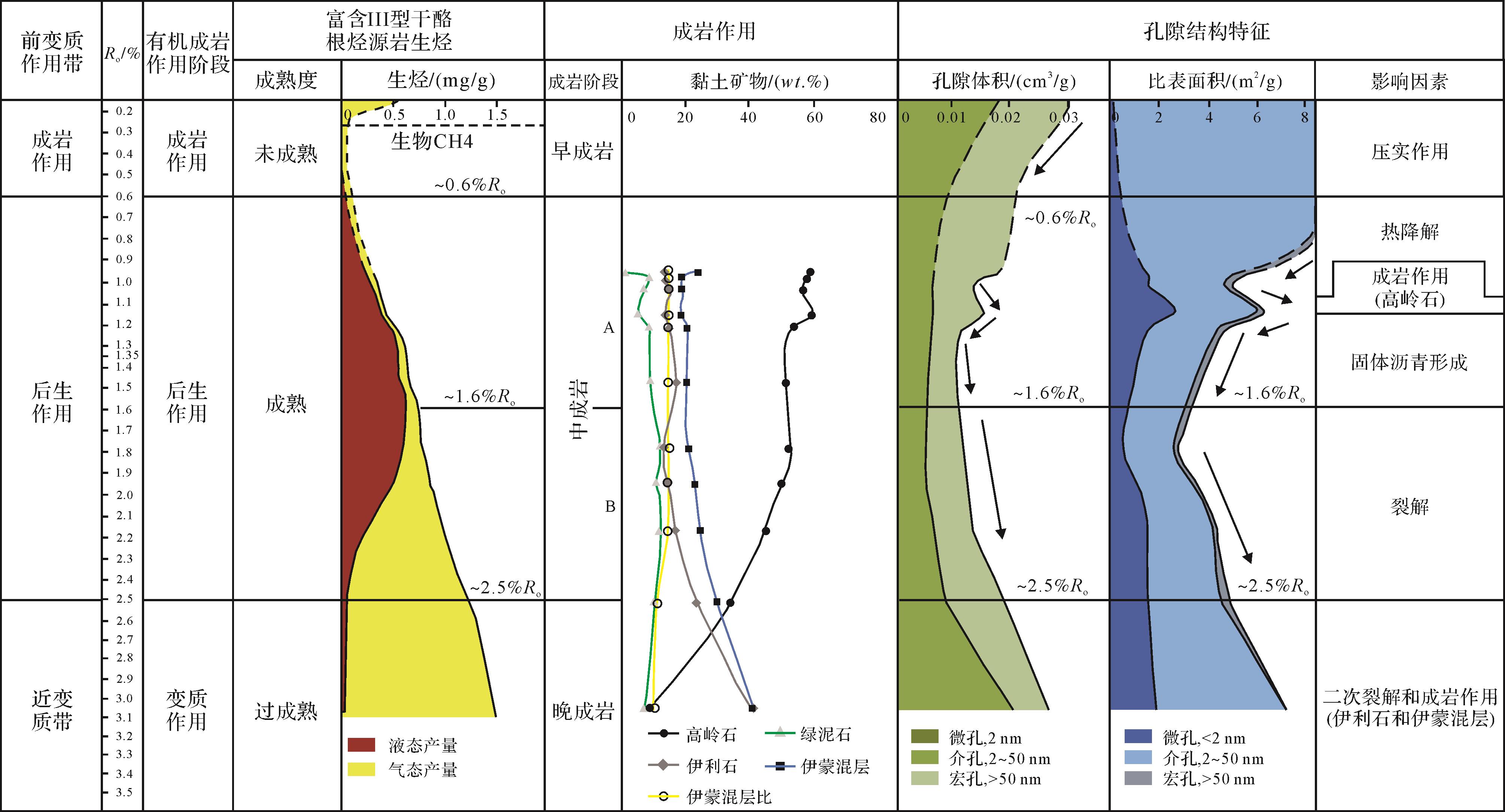HTML
-
页岩气资源在全球范围内十分丰富,中国页岩气藏分布十分广泛,全国海相页岩气资源量约为3.74×1013 m3,其中南方页岩气资源量约3.20×1013 m3,略低于美国,而技术可采资源量居世界第一[1-3]。资源潜力巨大的页岩气主要以吸附态和游离态赋存于页岩的微纳米孔隙中,泥页岩以微纳米级为主的基质孔隙空间连同相邻的自然裂缝,构成了页岩气的形成、储集、运移系统。纳米尺度下的孔隙类型、大小及分布很大程度上影响了页岩油气的储集性能和泥页岩的封盖能力,泥页岩“源—储—盖”一体的页岩气系统现已被众多学者普遍接受[4-7]。因此,泥页岩中的微纳米孔隙影响着页岩气的赋存状态及传输机制,进而对页岩气的成藏富集产生重要影响。而低孔低渗特征的泥页岩储层极大制约着页岩气的规模建产,作为衡量和评价储层优劣的重要因素,泥页岩微观孔隙储集空间的研究一直备受国内外石油地质学家的广泛关注[8-10]。
富有机质泥页岩中普遍发育微纳米孔隙系统,因受内因和外因的影响,其演化规律较为复杂。富有机质泥页岩的孔隙系统主要由有机质孔和无机矿物基质孔组成,在实际地质埋藏演化过程中孔隙系统的形成与演化,以及微纳米孔隙系统如何控制页岩气的富集成藏是近年来研究的热点和难点。目前,已有大量学者利用高精度和高分辨率的纳米级实验技术对不同演化阶段的自然成熟泥页岩样品的孔隙系统展开了全面而深入的表征与分析,以期揭示孔隙系统的构成、形成、演化的机理,并探讨其对页岩气成藏富集的影响。但因同一地区不同时代和沉积构造环境、不同地区不同物质来源的泥页岩受形成条件等多因素影响,自然成熟泥页岩的有机质特征、矿物组成和含量、结构构造等内部与外部的非均质性较强,学者们所得到的孔隙系统形成与演化的规律也各不相同[11-15]。为了避免地质非均质性的干扰,揭示热成熟生烃演化单一因素对孔隙系统形成与演化的影响,近些年来学者们普遍采用热模拟实验对未成熟—低成熟泥页岩样品进行人工熟化,期望建立统一的演化模式来探讨在此过程中孔隙系统形成与演化的规律[16-20]。但针对I型、II型、III型干酪根的富有机质泥页岩从未成熟、低成熟、成熟、高成熟至过成熟阶段全成熟度范围全面而深入的模拟实验较少,并且将其与自然演化样品进行对比,分析实际地质条件下孔隙系统形成发育规律的研究鲜有报道。大多数学者仅针对某种干酪根类型泥页岩在某一成熟阶段中孔隙系统演化进行了模拟,并且各个学者所采用原始样品的有机地球化学特征和矿物组成与含量,以及在不同模拟实验中所设置的模拟时间、升温程序、压力与流体条件各不相同,这些因素使得以往研究成果均难展示页岩在地质历史时期真实的演化规律,因而目前尚无统一且广泛适用的孔隙系统演化模式与规律可供对比分析和参考。
本文论述了近年来富有机质泥页岩孔隙系统孔隙表征研究的发展历程、形成与发育影响因素,总结了自然演化序列和模拟成熟序列泥页岩孔隙系统形成与演化的过程与模式,以期全面而深入地认识泥页岩孔隙系统的形成与演化规律,丰富页岩气微观储层评价科学理论,深化页岩油气资源成藏富集机理的认识,总结目前存在的科学问题,并提出研究展望。
-
经历数十年的历程,因表征仪器与实验手段不断向高精度、高分辨率、多维度的趋势发展,泥页岩微纳米孔隙在理论创新与实践认识方面取得了长足的进步,推动了泥页岩储层地质学与非常规油气地质学的发展。纵观国内外学者对泥页岩孔隙系统的研究进程,大致可以将泥页岩孔隙系统的研究划分为科学探索发现阶段、理论实践发展阶段、演化模式建立阶段。
-
1971年,O’Brien et al. [21]、Bennett et al. [22]利用显微分析技术对黏土矿物进行观察,发现丝片状黏土矿物可以通过面与面、面与边缘、边缘与边缘相互接触,并定向排列,可以形成“纸房构造”,这一发现首次聚焦于泥页岩微纳米孔隙系统,并将非常规储层相关的研究引入人们的视野。
1985年,IUPAC对固体材料进行研究时,对De Boer提出的吸附回线5分法进行改进,将N2吸附解吸曲线分为四种类型,对每种类型曲线所对应的孔隙类型进行了解释,这一研究后来被引用到泥页岩储层微纳米孔隙系统的表征中来,是现今常用的一种表征泥页岩中孔规模和形态的技术手段[23]。
1990年,O’Brien et al. [24]又发现了泥页岩的絮状黏土矿物聚合体中发育的开放孔隙,这些经过长期演化而被保留下来的开放孔隙和“纸房构造”能为分子直径为3.8 nm的甲烷提供吸附和聚集空间。因而,絮状黏土矿物中的粒间孔隙被认为是泥页岩中最早发现的储集空间。
1992年,Katsube[25]研究发现,埋深为4 400~5 600 m的页岩孔隙直径介于2.7~11.5 nm,而直径大于25 nm的孔隙较少。之后关于泥页岩孔隙相关的研究报道相对不多。
-
2001年至2010年是非常规纳米油气储层地质学飞速发展的十年。由于泥页岩储层具有不同于常规油气储层的孔径小、物性低等特征,因而常规油气储层表征技术应用于泥页岩储层时局限性较大。得益于聚焦离子束扫描电子显微镜(FIB-SEM)、场发射扫描电子显微镜(FE-SEM)、透射电子显微镜(TEM)、宽离子束扫描电子显微镜(BIB-SEM)、原子力显微镜(AFM)等高分辨率电子显微图像分析技术,高压压汞、低压N2和CO2吸附等流体注入技术,微纳米CT、核磁共振(NMR)、小角度中子散射(SANS)或超小角度中子散射(USANS)等非流体注入技术,泥页岩储层微纳米孔隙结构定性观察与定量分析得到了极大发展[26-27]。
2002年,Curtis[28]对美国Michigan盆地Antrim页岩,Appalachian盆地Ohio页岩,Fort Worth盆地Barnett页岩,Illinois盆地New Albany页岩,San Juan盆地Lewis页岩五大页岩气系统页岩气的成藏条件进行了分析,是较早全面介绍美国五大商业开发页岩气系统及孔隙特征的报道。
2003年,张金川等[29]较早论述了页岩气的成藏机理与成藏主控地质因素,认为页岩是既生又储的储集层,其孔隙和裂缝系统的发育程度决定了其含气丰度。
2007年,Jarvie et al. [5]发现TOC含量为7%的页岩在生烃过程中可以消耗35%的有机碳,使其孔隙空间增加4.9%,较早提出了生烃会使泥页岩孔隙空间增大的论断。
2009年,Singh et al. [30]首次提出泥页岩储层“纳米级孔隙”的概念,标志着泥页岩储层相关的概念体系和系统的孔隙分类开始建立。同年,Chalmers et al. [31]采用IUPAC的标准,将泥页岩中的孔隙分为微孔、介孔、宏孔,这种分类方案虽然不能准确的反应孔隙的形态、成因及连通性能,但这一分类却为泥页岩孔隙系统的定量表征奠定了基础。也是在2009年,Ross et al. [32]最早对美国Fort Worth盆地Barnett页岩中的有机质孔和孔隙网络进行了报道,揭示了富有机质泥页岩中绝大多数的纳米级孔隙分布于有机质中或形成于其边部。
2010年,Passey et al. [33]认为,泥页岩中50%以上的储集空间由纳米级的有机质孔隙提供,这一报道使有机质孔的重要性被人们所重视。同年,Sondergeld et al. [34]研究证实,泥页岩中的绝大多数孔隙分布于有机质中,其余的孔隙则与矿物成份与含量等因素有关,并将页岩中的孔隙分为矿物间孔、有机质孔、黄铁矿粒间孔、生物化石孔、微裂缝等。同年,Milner et al. [35]为了便于对北美不同层系的泥页岩展开研究,将其所观察到的孔隙分为基质晶间孔、有机质孔、粒间孔3大类。
2011年,Slatt et al. [36]对Barnett和Woodford页岩进行了氩离子抛光,然后进行扫描电镜观察,首次建立了有机质中的三维孔隙模型,并将泥页岩中的孔隙分为有机质孔隙、黏土絮体间孔隙、粪球粒内孔隙、化石碎屑内孔隙、颗粒内孔隙和微裂缝。同年,邹才能等[6]利用扫描电镜和纳米CT在中国四川盆地志留系页岩中发现了纳米级孔隙新类型,开启了微观储层特征与烃类演化时空匹配关系的研究,使油气勘探向致密油气和纳米油气方向发展,打破了国内油气储层宏观与微观二分的观点,标志着油气储层纳米级孔隙研究时代的到来。
2012年,Locuks et al. [37]以有机质孔、粒间孔、粒内孔为三个端元,将泥页岩储层的基质孔隙分为基质孔隙、有机质孔隙和微裂缝三类,这一分类方法是目前主要流行的页岩孔隙分类方案,奠定了泥页岩孔隙分类的研究基础。
2014年,Modica et al. [38]借助动态模型模拟了有机质孔形成与演化过程,提出随着埋深增加,矿物质孔隙规模不断减少,而有机质孔隙规模逐渐增加的规律。同年,焦堃等[27]在泥页岩表征复杂的孔隙系统时引入了概率熵、形状系数、分形维数等统计参数,其中概率熵能够反映孔隙的定向性,形状系数用于表征孔隙的圆润/粗糙程度,分形维数则可以揭示复杂形体的不规则性。白斌等[39]在泥页岩储层微纳米孔隙结构表征研究的基础上,建立了泥页岩孔隙表征实验技术方法、参数与流程,提出了原生微孔与次生微孔的分类方案。其中,原生微孔可细分为粒间微孔和晶间微孔,次生微孔则可分为粒内微孔、粒间溶蚀微孔、微裂缝。同年,于炳松[40]充分调研和总结了国内外学者的研究观点,提出了以产状和结构综合分类的页岩储层分类方案,这一分类被绝大多数学者引用,成为目前最具有代表性的分类体系之一。此后,也有学者对泥页岩的孔隙进行了分类,但大多未被广泛借鉴。
至此,泥页岩储层中普遍发育类型多样的微纳米级孔隙系统被学者们广泛接受。图像分析技术、流体注入技术、非流体注入技术等先进的高精度和高分辨率观测技术的利用,以及泥页岩储层微纳米孔隙多种分类方案的提出,为泥页岩微纳米孔隙形成与演化机理的研究奠定了基础,为泥页岩微纳米孔隙演化模式的研究提供了技术支撑。
-
针对泥页岩孔隙特征的静态表征,国内外学者已在孔隙的形态、类型、成因、规模、分布与连通性等各方面开展了大量研究,经过前期的广泛积累,泥页岩孔隙特征的静态表征已有较为成熟的理论基础体系,泥页岩孔隙系统的研究也逐步趋于定量化。然而,现今的泥页岩是地质历史时期演化的产物,为了揭示地质历史时期泥页岩孔隙的形成与演化过程,明确页岩油气赋存富集机理,近些年来大量学者展开了泥页岩动态演化规律的研究,泥页岩储层微纳米孔隙系统的动态演化规律也逐渐系统而深入。
2014年,Chen et al. [16]通过封闭体系玻璃管在无水条件下对三块TOC含量不同的样品进行了热模拟,首次用物理模拟实验的方法揭示了泥页岩微纳米孔隙结构在热成熟过程中的动态演化规律,并将富有机质泥页岩孔隙体积和比表面积的形成与演化划分为形成阶段、发展阶段、破坏阶段(图1)。
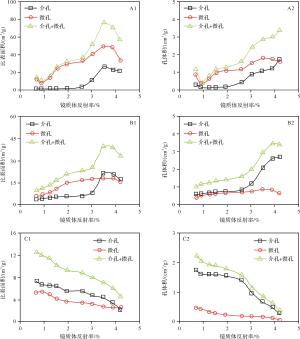
Figure 1. Surface area and pore volume of micro⁃and mesopores as functions of thermal maturity, as indicated by virtinite reflectance (modified from reference[16])
2015年,Wang et al. [41]最早使用多尺度定性与定量相结合的方法,联合使用低压CO2吸附、低压N2吸附、高压压汞法、扫描电镜等技术对泥页岩孔隙结构进行了表征(图2)。同年,Tang et al. [42]和Hu et al. [43]分别利用物理模拟的方法在室内模拟了泥页岩微纳米孔隙的动态演化过程,并利用流体注入技术对这一演化规律进行了定量表征。
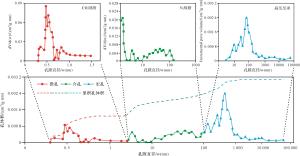
Figure 2. Full⁃scale distribution of pore volume with pore size in shale (modified from reference[41])
2016年,Wang et al. [44]基于扫描电镜网格划分微孔隙辨识测量技术,结合Image J孔隙定量分析技术,对扫描电镜照片中孔隙信息进行提取和二值化处理,通过调整扫描电镜照片的灰度值,将矿物基质信息、有机质信息等其他信息过滤,而只保留孔隙信息,以此实现了对泥页岩孔隙形态与规模等特征的精确定量表征。在此基础上,Wang et al. [44]引入多重分形几何理论对泥页岩储层的多重分形维数进行计算,有效的表征了泥页岩储层的非均质性,建立了孔隙分布非均质性与储集能力之间的关系,并对泥页岩储层的储集能力进行了评价(图3)。
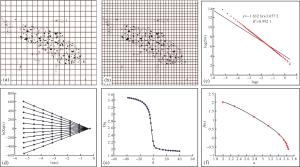
Figure 3. (a⁃c) Fractal analysis process and results based on organic pore extraction; and (d⁃f) procedure for calculating the multifractal spectrum for SEM (modified from reference [44])
近年来,许多学者采用物理模拟的方法对泥页岩孔隙系统形成与演化的过程进行了模拟,在多尺度定性与定量表征技术的支持下,清楚直观地表述了泥页岩孔隙系统动态的形成与演化过程。因而,泥页岩微纳米孔隙系统特征的研究,逐渐从静态单一技术的表征向动态物理模拟联合多尺度定性与定量相结合的表征方向发展。
1.1 科学探索阶段(1971—2000年)
1.2 理论成型阶段(2001—2014年)
1.3 飞越发展阶段(2014年至今)
-
通过对北美主要页岩气高产区以及我国页岩气勘探开采示范区的泥页岩孔隙特征进行系统梳理和全面总结,发现富有机质泥页岩的孔隙构成具有异于常规油气储层的复杂孔隙系统特征,不同地区时代、不同形成条件的泥页岩微观孔隙发育类型不同,具体体现在:1)泥页岩储层具有富含微纳米孔隙的特征,孔径较小,结构致密,连通性差,因而其物性特征显著低于常规油气储层,也较常规油气储层孔隙更难分类与识别鉴定[5,37,40];2)不同于常规油气储层,泥页岩储层的孔隙既常见于石英、长石、方解石、黏土矿物等矿物基质,也可大量形成于有机质中,而常规油气储层的孔隙则主要发育于砂岩中[7,45-46];3)与常规油气储层孔隙结构主要受控于成岩作用不同,泥页岩孔隙结构的形成与演化既与矿物成岩作用密切相关,更受有机质生烃和排烃作用的影响。比如,有机质生烃形成大量微纳米孔隙的同时会产生有机酸,将对页岩中的易溶矿物进行溶蚀,导致泥页岩的孔隙发育规模增大,而有机质排烃等一般会造成泥页岩的孔隙结构参数及孔隙度降低[19,47-48];4)除无机矿物成分外,泥页岩孔隙结构和构造的发育程度也与有机质类型、含量、热成熟度及分布特征紧密相关[49-50]。因此,与常规油气储层相比,泥页岩微纳米孔隙广泛发育且与有机质密切相关,是富有机质泥页岩孔隙结构的重要特征。
值得提出的是,泥页岩储层中独特的孔隙类型——有机质孔,主要形成于有机质热成熟生烃过程中,分布在有机质内部或边缘,大小为几纳米至几百纳米,平均孔径一般小于粒间孔、粒内孔、晶间孔、晶内孔等矿物基质孔隙[6,51-52]。在未成熟—低成熟的泥页岩中,有机质孔主要以生油孔为主,形态呈圆形、椭圆形、不规则状等,分布孤立,连通性较差。在成熟至高成熟阶段的泥页岩中,有机质孔则以生气孔为主,孔隙大小比生油孔更小,形态呈圆形、椭圆形、棱角状或次棱角状,分布孤立且密集,与生油孔不易区分。而在过成熟及成熟度更高的泥页岩中,生气孔将大量生成,大面积连片分布于有机质内部或边缘,形态类似于海绵状,呈蜂窝状、片麻状,部份有机质孔隙孔径扩大,与周边相邻孔隙连通[53-54]。此外,有机质孔隙的比表面积大,结构较为复杂,大量气体可吸附于有机质表面,或呈游离态富集于有机质孔中。有机质孔隙在二维和三维空间具有一定的连通性,这对于页岩油气的吸附、渗流和聚集具有重要意义。
-
泥页岩微纳米孔隙形成与演化的影响因素总体上分为内因和外因,外因主要为沉积环境、构造背景、地层埋深、温度和压力等,而内因则是岩性、矿物成份、TOC含量、有机质类型与成熟度、厚度和湿度等[55-57]。泥页岩中各种类型孔隙的成因与演化机制较为复杂,各种内外因在其形成与发育的不同时期对其影响程度不同。
在外部控制因素中,沉积环境、构造背景共同决定了泥页岩微纳米孔隙系统发育的物质基础条件,并进一步控制了泥页岩微纳米孔隙的形成与演化。泥页岩形成时的古地理格局、沉积环境和母岩类型对泥页岩岩相和物质组成具有明显的影响,不同沉积环境条件下发育的泥页岩有机质母质来源存在较大差异,这就意味着影响孔隙结构特征的主控因素不同,不同沉积环境下形成的富有机质泥页岩,其孔隙结构,特别是有机质孔隙特征主要受有机质母质来源的控制。Wang et al.[58]对比了海陆相沉积富有机质泥页岩地质特征,结果发现因物源与沉积环境不同,海陆相页岩虽然矿物组成上有一定的相似性,但在含量上较别较大,正是这些矿物组成的差异致使成岩过程中岩石抗压实能力不同,进而影响页岩中矿物基质孔与有机质孔的形成与演化。Yang et al.[59]对我国四川盆地下志留统龙马溪组为代表的海相页岩、下二叠统山西组为代表的海陆过渡相泥页岩、鄂尔多斯盆地三叠系长7段为代表的陆相泥页岩的纳米孔隙结构特征进行了对比分析,发现有机质孔对海相页岩的孔体积和比表面积贡献更大,而黏土矿物相关的孔隙对海陆过渡相和陆相页岩的孔体积和比表面积贡献更大。此外,其还发现海相页岩的孔体积和比表面积均大于过渡相及陆相页岩,海相页岩主要以小于10 nm的墨水瓶型有机质微中孔为主,而过渡相和陆相富有机质泥页岩则主要发育30~70 nm的黏土矿物狭缝型中—宏孔。构造条件稳定,各种矿物类型较为发育,古生物化石丰富,有机质含量高,构成了页岩储层微纳米孔隙形成的物质基础,致使页岩形成硅质页岩、钙质页岩、粉砂质页岩等不同岩相,并发育不同类型的微纳米级孔隙[56]。
在内部影响因素中,岩性与矿物组成的变化控制了页岩岩石力学性质和孔隙结构,使得泥页岩孔隙空间有一定程度的增大或减小[52]。国内外具有商业开发价值的海相、陆相、海陆过渡相页岩的脆性矿物含量一般都高达40%,这一标准适合后期页岩气的开发压裂改造;脆性矿物的富集将使泥页岩抗机械压实能力提高,有利于页岩原生孔隙的保存,也可以使页岩更易产生裂缝。已有研究表明,脆性矿物含量与各级别孔隙呈现出一定程度的正相关关系,在不同地区这一规律也会有所不同,这一特征与不同的地质条件和成岩作用有关[60-61]。黏土矿物的类型和含量也对页岩纳米孔隙的类型与数量具有重要影响。Bustin et al.[62]认为页岩中黏土矿物具有较大的比表面积和较高的孔隙体积。吉利明等[9]认为蒙脱石具有的孔比表面积显著高于伊利石、绿泥石、高岭石等,并且不同黏土矿物晶层及孔隙结构不同,孔比表面积存在很大差别。另外,在不同的成岩作用阶段,黏土矿物之间会发生相互转化和脱水作用,产生层间微孔隙。脆性矿物与黏土矿物的相对含量及页岩微纳米储集空间发育的相关性定量研究也已有大量学者报道。
TOC含量和干酪根类型影响着有机质孔隙发育的孔体积和比表面积,而有机质演化则制约着不同类型孔隙的演化趋势[55-56, 63]。已有较多研究表明,TOC含量对页岩储层孔隙具有重要的贡献作用,TOC含量与泥页岩各孔径范围孔隙的孔体积、比表面积、孔隙度大多呈正相关关系,是影响页岩纳米孔隙体积、比表面积、孔隙度的主控因素[46,64-65]。Behar et al.[66]研究发现,页岩中5~50 nm的孔隙尺寸取决于干酪根类型,由偏腐泥混合型干酪根到腐泥型干酪根,泥页岩的孔隙度和比表面积均减小。张廷山等[61]研究发现川南早古生代海相II型干酪根页岩中微观孔隙的比表面积和孔体系比I型干酪根页岩更发育,认为这是由于II型干酪根主要来源于高等浮游生物,其内部结构较大且较为复杂,形成的II型干酪根含有多环芳香烃及杂原子官能团,使得微观孔隙一般比I型干酪根大,进而对页岩的比表面积、孔体积等产生影响。有机质成熟度与页岩微观储层孔隙并不是单纯的正相关或负相关关系,纳米孔隙随着热演化程度如何变化也存在较大的争议,因为有机质成熟度是泥页岩发生各种地质作用的综合体现[61-63,67]。随着成熟度的增加,泥页岩中的有机质将不断的生烃,并且矿物成分也将不断发生转化,为了揭示这些问题,国内外较多学者对成熟度与孔隙系统演化的相关关系开展了定性或定量的研究。例如Curtis et al.[68]对Woodford盆地成熟度为0.51%~6.36%的页岩进行研究,发现成熟度低于0.9%的样品中有机质微孔较少,当成熟度增加至2.0%时,有机质微孔数量逐渐增多,成熟度大于2.0%以后有机质孔隙数量反而减少。Hu et al.[43]和Sun et al.[47]均对低成熟页岩样品进行了模拟,并对模拟后的固体样品的孔隙特征进行分析,发现随热成熟度的增高,相应的孔隙结构参数和孔隙度随有机质成熟度呈规律性的增加。而Xu et al.[20]通过物理模拟实验发现,随成熟度的增加,泥页岩的孔隙结构参数呈先减小后增大而后再减小的变化规律,其分别在成熟度为0.86%和3.28%时达到最小值和最大值。
综上可知,泥页岩微纳米孔隙系统的发育与演化是多方面因素综合作用的结果。目前也有较多学者普遍认为,成岩作用和有机质生烃作用也是泥页岩储层纳米孔隙系统发育的主控因素。其中,压实作用和胶结作用等成岩作用是主要的减孔成岩作用,而溶蚀作用则是主要的增孔成岩作用[69-71]。
压实作用是影响泥页岩原生粒间孔、粒内孔最为显著的成岩作用,泥页岩自沉积之后逐渐深埋过程中,因上覆沉积物的重量以及水体的重压,使大量的孔隙水从泥页岩的孔隙系统中排出,此期间的机械压实作用致使泥页岩的孔隙度迅速降低,原生的粒间孔、粒内孔,以及部分晶间孔和晶内孔等也将遭到严重的压实破坏,而使泥页岩储层逐渐致密。郭秋麟等[72]认为,当埋深达到1 000 m、2 000 m、3 000 m时,泥页岩的孔隙度分别从其刚沉积时的60%~80%降低至27%、16%、11%。在深埋压实过程中,石英、长石等刚性矿物颗粒的存在将有利于孔隙的保存,而黏土矿物等易被挤压变形的矿物成分容易导致孔隙结构破坏[73-75]。埋藏成岩过程中,因地温升高和黏土矿物的转化,泥页岩中也将形成方解石、黄铁矿颗粒等自生矿物颗粒,重结晶于泥页岩的孔隙裂缝中,也会致使泥页岩的孔隙空间减小[74,76-77]。
有机质生烃作用是不同于常规油气储层而属于泥页岩储层的一种独特的成岩作用类型,正是泥页岩的有机质生烃作用使其有机质孔隙得以生成、发育并发生演化。在泥页岩地层埋深增加,地温逐渐升高的过程中,有机质的成熟度将不断升高,与此过程相伴随的是烃类的不断生成与有机质孔隙的不断形成与演化[77-79]。有机质或干酪根在生烃的同时将排出有机酸,这些酸性流体是泥页岩产生溶蚀作用的主要动力,泥页岩中长石、碳酸盐岩等易溶矿物在这些酸性流体的作用下部分或全部被溶蚀,形成次生溶蚀孔隙,致使泥页岩孔隙空间变大,储集条件得以改善[77,80-81]。
2.1 富有机质泥页岩微纳米孔隙系统特征
2.2 富有机质泥页岩微纳米孔隙系统发育影响因素
-
与常规油气储层孔隙的演化主要受控于无机成岩作用不同,泥页岩作为烃源岩和储层,其孔隙系统的动态演化不仅受到无机成岩作用的控制,还受有机质的热成熟生烃作用的影响[5,82-83]。一方面,有机质热成熟作用不仅控制有机质孔的形成与演化,而且对无机孔隙形成与演化的影响较为明显。另一方面,有机质热成熟作用在控制泥页岩生、排烃能力的同时,还决定着泥页岩中产生有机质孔隙的规模、分布、连通性能,对页岩气赋存的主要载体——有机质及有机质孔影响显著。总体来看,目前学者们主要采用两种方法建立了泥页岩孔隙演化模式。第一种方法是直接对不同成熟度的自然成熟序列样品采用多种手段表征不同尺度的孔隙结构,对比不同演化阶段孔隙结构的变化特征,分析孔隙系统演化规律。因这一方法所采样品的地质背景各不相同,因而得到的演化规律也不一致,随着自然成熟序列页岩样品成熟度的增大,泥页岩孔隙数量和规模增大或减小,有的甚至并无明显变化规律[11-13,78,84]。第二种是采用物理模拟法,对未成熟或低成熟的样品开展物理模拟实验,获取不同成熟度阶段的样品,再利用图像分析技术、流体注入技术、非流体注入技术对热演化系列样品孔隙形态、规模及结构参数等进行表征,定性或定量地反演孔隙演化的全过程,并建立基于模拟实验的孔隙系统演化模式[16-17,19-20]。
-
采用不同成熟度的自然成熟序列样品的对比分析来揭示纳米孔隙系统演化规律的方法优势明显,该方法是对目的层地质历史时期不同成熟度自然演化序列样品展开对比研究,分析不同时期不同成熟阶段泥页岩样品的微纳米孔隙系统特征,总结自然成熟序列样品孔隙系统演化模式。这一方法能真实可靠的反应泥页岩在实际地质条件下的演化规律,但因样品的微观非均质性及区域差异,且部分地区页岩的埋深和分布不一,不同成熟度自然演化序列样品难以获得,且所得规律受非均质性等各方面因素的干扰。因此,这一方法不能系统性的展示孔隙演化的过程,而且目前尚未获得统一的基于自然成熟序列的泥页岩微纳米孔隙系统演化模式。
Curist et al. [11]是较早利用自然成熟序列样品进行泥页岩孔隙系统演化研究的学者,其利用氩离子抛光结合扫描电镜技术对Woodford盆地东部地区不同成熟度的Barnett页岩孔隙结构的观察分析,是早期直接观察法最典型的代表,其发现当成熟度低于0.9%时泥页岩的有机质孔不发育,而进入“生气窗”以后因液态烃开始热解和裂解,泥页岩孔隙空间得以释放,有机质孔大量发育,孔隙体积开始增加,但是其并未建立不同成熟序列泥页岩孔隙系统演化的一般规律与模式。Mastalerz et al. [14]研究了采自Illinois盆地的5块成熟度介于0.35%~1.41%的New Albany页岩样品孔隙结构特征,发现在成熟度增加至1.41%过程中,孔隙体积间歇性减小是因生成的石油和沥青充填孔隙,而间歇性增大则与所生成的石油和沥青被热解或裂解而释放其所占据的孔隙空间有关。在此基础上,其首次建立了孔隙度和微纳米孔隙在热成熟生烃过程中的一般演化模型(图4),然而该模型样品较少,且缺乏高过成熟阶段(R o>1.5%)孔隙演化规律的数据分析。此后,较多学者所得出的自然成熟序列泥页岩的孔隙演化模式也是在这一模式基础上进行数据的补充和修改。
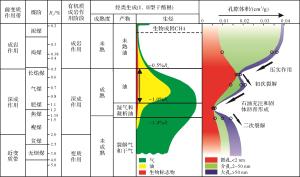
Figure 4. Schematic diagram relating the observed changes in porosity maturation and hydrocarbon generation. Open circles on the porosity curves indicate the positions of the samples studied (modified from reference[14])
另外,值得一提的是Zhao et al. [85]对四川盆地五峰—龙马溪组四种岩相的自然成熟序列页岩在各个成岩阶段孔隙系统的演化特征进行了定性与定量表征分析,并建立了热成熟生烃与成岩作用过程中矿物基质孔和有机质孔演化的概念模式(图5)。认为随着热成熟度的增加和成岩作用的进行,页岩逐渐变得致密,原生孔隙空间逐渐减小,次生孔隙则主要形成和发育于硅质、粉砂质、钙质/白云质三种岩相的页岩中。其中,有机质孔隙主要是因硅质页岩中干酪根的生烃所产生,干酪根在高—过成熟阶段生烃的同时可形成大面积连片分布的有机质孔。而次生矿物孔隙主要是粉砂质和钙质/白云质页岩中长石和白云石被溶蚀所形成的粒内溶蚀孔。这一演化模式将有机质生烃与成岩演化联系起来,客观生动地展示了热成熟度增加过程中所发生的成岩演化规律,揭示了常见的四种不同类型泥页岩中有机质孔隙和无机质孔隙的演化现象。
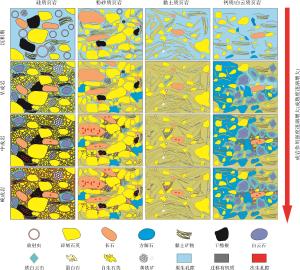
Figure 5. Conceptual model of detrital components controlling diagenetic pathway of natural mature sequence samples of Wufeng⁃Longmaxi Formation shale in Sichuan Basin (modified from reference[85])
近些年来,随着页岩油气勘探开发热潮的到来,国内外学者也加大了对泥页岩储层微纳米孔隙空间的研究力度。Topór et al. [12]对波兰Baltic盆地下志留统自然成熟序列页岩孔隙演化特征进行研究,建立了成熟度介于0.4%~3.5%的孔隙演化模式,但该模式在成熟度大于2.0%区域内的数据较为缺乏,因而这一模式在高过成熟范围内的演化趋势存在较大的不确定性。Pommer et al. [50]基于美国德州Eagle Ford自然成熟序列页岩的研究,建立了成熟范围处于0.5%~1.3%区间的孔隙演化模式,但这一研究并未解释R o>2.0%这一高过成熟区间孔隙的演化过程。Mastalerz et al. [14]所建立的孔隙演化概念模型较为直观,但该模型也缺乏R o大于1.41%的实测样品数据,对于高—过成熟阶段因样品数量较少,因而其孔隙的演化规律也不确定。Wang et al. [13]在统计前人研究数据的基础上,选取川南五峰—龙马溪组页岩为研究对象,建立了从未成熟至过成熟范围区间的孔隙结构演化模式,该模式的建立标志着自然成熟序列泥页岩孔隙演化模式已趋于成熟和完善(图6)。
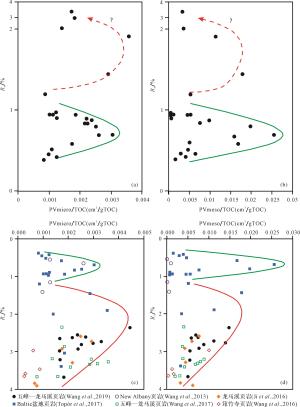
Figure 6. Pore structure evolution model of natural mature sequence samples (modified from references[12⁃13])
此外,Wei et al. [75]基于鄂西宜昌地区黄陵背斜下寒武统水井沱组20件成熟度为2.18%~2.73%的过成熟富沥青质页岩有机质孔隙的定量研究,明确了有机质和矿物成份对泥页岩孔隙结构的影响,并借助FE-SEM鉴别了干酪根和沥青质中的海绵状原生与次生有机质孔,认为这些有机质孔隙的形成与发育和有机质的热成熟生烃作用有关,并建立了未成熟至过成熟阶段富有机质泥页岩中有机质孔隙演化的概念模型,该模型对热成熟过程中有机质孔隙的演化过程进行了清晰和直观的展示(图7)。
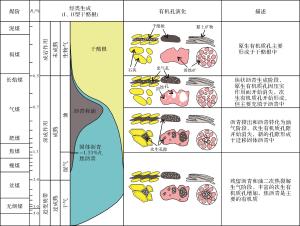
Figure 7. Schematic representation of the evolution of organic pores from immature to overmature stage (modified from reference[75])
综上可知,目前学者们建立的自然成熟序列泥页岩孔隙系统演化模式主要是与有机质生烃和成岩作用结合起来所建立的。成熟度是泥页岩埋藏演化和成岩生烃的综合体现,随着成熟度增加至0.5%并进入生烃门限,泥页岩主要因机械压实而逐渐致密,微纳米孔隙空间在此阶段逐渐减小。在成熟度增加至约1.0%时,有机质达到生烃高峰,此时有机质生烃产生的有机酸对泥页岩的孔隙空间进行溶蚀,使孔隙空间在此阶段有一小幅度的增大,但其生成的烃类堵塞孔隙空间和压实作用的持续进行将至使孔隙空间在R o达到1.0%时逐渐减小。在成熟度大于1.0%的高—过成熟阶段,各个学者所得出的孔隙演化规律各不相同,但是在此区间有机质生烃将使有机质出油孔和出气孔的数量逐渐增加,从而使泥页岩的孔隙体积和比表面积逐渐增大,而此后的强压实作用和有机质内部孔隙的逐渐坍塌,也将一定程度上使有机质孔和矿物基质孔隙空间减小。
-
通过物理模拟获取不同成熟度样品来揭示泥页岩孔隙系统演化规律的方法能更加快速便捷地观察到热成熟过程中孔隙结构演化的规律,用以指导勘探实践。但这一方法也因研究目的、所选样品、实验条件的不同,各个学者提出的演化规律各不相同。物理模拟法虽在一定程度上降低了地质条件对样品非均质性的影响,样品的演化虽主要受热成熟度单一因素控制,可对比性较强,但也存在较多缺点,譬如难以真实模拟各个地质历史时期实际的演化过程。再比如模拟手段主要分为封闭体系(封闭,产物不收集)、半开放体系(封闭,产物收集)、开放体系(开放,产物随产随排),孔隙结构的演化也会受到人工模拟实验手段,以及如流体压力、地层压力等实验条件的影响[77,86-89]。对于大多数学者而言,在设置条件时都加入高压液态水,以期接近实际的地质条件,在相近的地层流体压力、静岩压力、温压条件下开展热模拟实验。尽管如此,由于所选模拟样品的不同,孔隙表征的手段不同,得出的结论也不一致[82,86,90-91]。
吴松涛等[18]对鄂尔多斯延长组长7泥页岩原始样品和模拟后样品在同一位置开展纳米CT扫描、FE-SEM、低温N2吸附表征,较早建立了各温度下人工模拟样品二维与三维孔喉系统定性与定量相结合演化模型。该模型显示样品的孔隙发育程度随热演化程度的升高先减小而后增大,大体上可以将演化过程划分为快速减小阶段、快速发育阶段、保持稳定阶段(图8)。
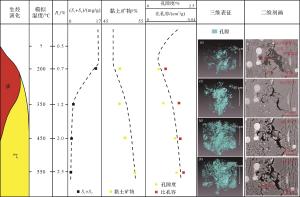
Figure 8. Pore system evolution comprehensive model of Triassic Chang 7 in Ordos Basin (modified from reference[18])
Sun et al. [17]利用WYMN-3型高温高压生排烃模拟仪,控制静岩压力、流体压力、恒温时间、加热温度等实验参数对富有机质泥页岩进行物理模拟,对模拟后样品的孔隙结构参数定量表征,揭示了孔隙结构参数在热成熟过程中的变化规律。Sun et al. [47]在其前期研究的基础上,采用相同的模拟方法再次展开了模拟研究,揭示了不同模拟温度下有机质生烃演化与孔隙结构发育特征的关系,其研究结果与Chen et al. [16]有些类似,将总孔体积与总比表面积的演化大体上划分为调整、形成、发展三个过程,并将泥页岩孔隙结构参数在模拟成熟度增加过程中的演化过程分为250 ℃~300 ℃、350 ℃~375 ℃、400 ℃~500 ℃三个阶段。发现在热成熟度升高过程中,介孔结构参数在250 ℃至300 ℃的模拟初期变化不明显,自300 ℃显著增大,自450 ℃至模拟结束转而减小,而宏孔和微孔结构参数演化特征并无明显规律(图9)。
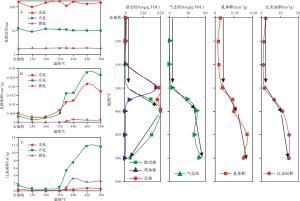
Figure 9. Pore structure, explusion and residual hydrocarbon evolution characteristics in thermal hydrocarbon generation (modified from reference[47])
Guo et al. [19]基于鄂尔多斯盆地延长组II型低成熟富有机质泥页岩利用封闭玻璃管体系和自行设计的压机半封闭体系热模拟系统开展了物理模拟,并对封闭体系和半封闭体系泥页岩总孔、宏孔、介孔、微孔的孔隙体系演化规律进行对比。结果显示,在模拟温度在300 ℃至600 ℃这一主要生油阶段,残留沥青可以充填页岩中初始孔隙和新生成的孔隙,在主生油阶段以后,由于排烃作用的影响,页岩孔隙更加发育。此外,随着热演化程度的升高,与介孔、大孔的发育模式明显不同,页岩微孔的发育主要与气体或者轻烃的排烃有关,模拟升温使封闭体系和半封闭体系微孔体积在350 ℃降低至最小值后逐渐增加。由于半开放体系中的有机质演化较慢,尤其是残留沥青的二次裂解较为迟缓,以及半封闭体系生成的烃类部分被排出而不会占据样品的孔隙空间,因而导致压机半封闭体系热解样品的介孔、宏孔、总孔体积的增长都明显高于封闭玻璃管体系(图10)。
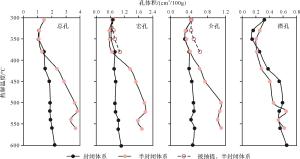
Figure 10. Relationship between pyrolysis temperature and (a) total pore volume; (b) macropore volume; (c) mesopore volume; and (d) micropore volume of pyrolyzed and original samples (modified from reference[19])
Xu et al. [20]对未成熟II型富有机质泥页岩展开了封闭体系的无水热模拟实验,模拟了从未成熟至过成熟阶段(0.48%~4.05%)的孔隙演化过程,揭示了未成熟至过成熟这一较宽成熟度范围内孔隙演化的规律,将微孔、介孔、宏孔孔隙结构的演化划分为孔隙调整阶段、孔隙发育阶段、孔隙转化或破坏阶段,并在此基础上建立了基于热模拟实验的微纳米孔隙结构演化模式,该模式将微纳米孔隙与吸附气量的演化划分为生油阶段(EqR o<1.0%)、油裂解气阶段(1.0%<EqR o<3.28%)、湿气裂解阶段(EqR o>3.28%)。相对来说,这是一套完整热成熟序列的II型富有机质泥页岩在无水条件下的孔隙系统演化模式,较为全面的展示了富有机质泥页岩孔隙系统从未成熟阶段至过成熟阶段全过程的演化规律(图11)。
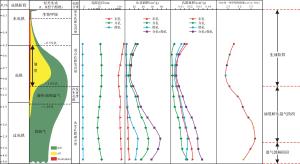
Figure 11. Evolution characteristics and model of nanoscale pore structure and adsorption capacity of oil shale during artificial thermal maturation (modified from reference[20])
此外,值得注意的是马中良等[90]对西加拿大盆地未熟页岩开展的热模拟实验,发现页岩中有机质孔隙的形成与演变具有非均质性,成熟度不是控制有机质孔形成与发育的唯一决定因素,有机质生烃时所发生的物理化学变化对有机质孔的形成演化具有重要影响,同时生油阶段生成的有机质孔容易被热解沥青堵塞。Guo et al. [81]认为,封闭体系中有机质的生烃作用对无机孔隙的演化规律同样起到一定的控制作用,有机质热演化作用会产生有机酸,这些有机酸将导致黏土矿物成分与组构发生变化,使得黏土矿物孔隙演化规律更加的复杂。同时有机质生烃过程中产生的酸性流体使得储层中碳酸盐、长石等不稳定的矿物发生溶蚀,产生大量的次生溶蚀孔(图12)。
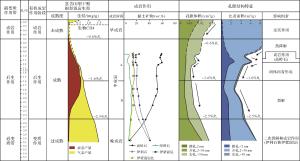
Figure 12. Schematic diagram relating changes in pore volume and surface area to diagenesis and hydrocarbon generation (modified from reference[81])
因此,需要注意的是封闭体系、半封闭体系、开放体系生成油气的量存在一定的差异,油气在升温过程中会发生热解或裂解,这必将不同程度影响富有机质页岩在模拟升温过程中孔隙结构的演化特征。烃源岩是一种边生边排的半开放体系,其生排烃的过程并不是绝对封闭或开放,在实际地质条件下,生成的烃类会有部份排出烃源岩而不会被热解或裂解,残留于烃源岩中的烃类将遭受热裂解。液态烃的排出及残留烃裂解的过程将对泥页岩在模拟过程中孔隙结构的演化产生显著影响。因而,一般情况下半封闭体系和开放体系在模拟升温过程对有机质的消耗将比封闭体系大,并且自生油窗之后孔隙结构的增量也比封闭体系大。在选择模拟实验时,应注意不同的体系对实验过程中产物的影响以及地质过程的可对比性,也要考虑到是否加水的实验条件,因为水的存在会为烃源岩生排烃过程和黏土矿物的转化提供大量的H源,可能会对泥页岩孔隙系统的演化过程和结果产生显著影响。
以上两种研究方法均存在各自的优势与局限性,在讨论所研究样品的微孔缝动态演化规律时,应结合自然序列样品与不同体系的物理热模拟样品展开对比研究,并与实际地质条件结合,建立完整生烃过程的孔隙结构演化模式,从而能更加准确真实地揭示页岩孔隙结构实际演化机理。
3.1 自然成熟序列泥页岩孔隙系统演化模式
3.2 模拟序列泥页岩孔隙系统演化特征
-
富有机质泥页岩孔隙系统纷繁复杂,类型、形态、演化规律多样,连通性能多变,孔隙既存在于石英、长石、黏土矿物等矿物基质,也广泛发育于有机质中。富有机质泥页岩孔隙系统及其演化的研究是揭示页岩油气成藏富集机理的关键,也是非常规油气地质学研究的热点和难点。而富有机质泥页岩孔隙系统的形成与演化是多种内因与外因综合作用、互相耦合的结果。沉积环境决定了富有机质泥页岩形成孔隙的生烃条件和物质基础,而其所处环境的埋藏史与热演化史则决定了其生排烃作用与成岩演化过程。富有机质泥页岩中有机质生烃与无机矿物成岩的动态耦合致使其孔隙系统无时无刻不在发生着演化。本文总结了前人的研究成果,分析认为富有机质泥页岩孔隙系统演化的研究还存在以下问题仍需进一步展开研究:
(1) 不同物源条件和沉积环境下形成的富有机质泥页岩,其成岩过程和有机质类型各不相同,在热成熟生烃和成岩作用过程中孔隙系统演化的模式也可能有所不同。因而在进行模拟研究之前,应有针对性的选择不同沉积环境和不同有机质类型的样品进行深入研究,以弥补这一研究领域的缺陷,完善不同物源条件和沉积环境下形成的富有机质泥页岩孔隙系统演化规律差异的研究。
(2) 应加强富有机质泥页岩微纳米孔隙系统各项主控因素对其演化的定性、定量分析研究,深入分析热成熟生烃作用和成岩作用对富有机质泥页岩微纳米孔隙系统演化的影响,探讨各种内因和外因与各类微观孔隙在演化过程中的相关性,尤其应揭示脆性矿物、黏土矿物和有机质类型、TOC含量、成熟度等单一因素与孔隙系统演化的相关性,对此可以利用模拟实验通过控制变量法来揭示各个单一因素影响下孔隙系统演化的规律,采用定性与定量相结合的方法来展示这一演化过程,并在此基础上总结多因素、系统性、非均质性等因素对孔隙系统演化的影响。
(3) 应改善模拟系统和模拟实验条件,使之更接近真实地质条件。目前各个高校和研究机构模拟实验装置繁多,根据各自的研究目的不同,目前设有封闭体系、半开放体系、开放体系等,也有无水与含水等热模拟实验,得到的孔隙系统演化规律也是各有不同且差异较大,因而实验装置的选择和人为因素等对孔隙系统演化规律的揭示影响较大。在后续孔隙系统演化规律的研究中应进一步通过控制加热条件、压力条件、供液条件、产物收集条件、总控制条件和辅助条件来模拟不同的地质环境,使得到的孔隙系统演化模式更加逼近实际地质条件。
(4) 提高不同成熟度序列样品微纳米孔隙系统测量精度和范围,并联合使用多维观测技术对孔隙系统多维演化特征进行表征。目前国内外广泛使用的流体注入技术、非流体注入技术、图像分析技术能够详细的表征页岩孔隙形态、类型、规模、分布等特征,但这些方法普遍存在一定的局限性。例如目前较前沿的Nano-CT技术能够无损分析、连续扫描并对页岩孔隙系统的演化进行三维重构,但其所测样品非常细小,不能代表岩石的孔隙系统分布,也不能较好的反应页岩的非均质性所造成的影响且实验价格昂贵。再比如目前较常用的低压气体吸附需要将页岩样品粉碎到粒径至少为微米级别才能展开实验,但这一粉碎操作可能破坏了样品原始的孔隙系统结构属性,而使测试结果失真。未来微纳米孔隙系统测量的技术应向廉价便捷、高效率、高精度、宽范围方向发展,使泥页岩孔隙系统的演化能够直观地、清晰的、形象地、多维度定性和定量的进行表征。

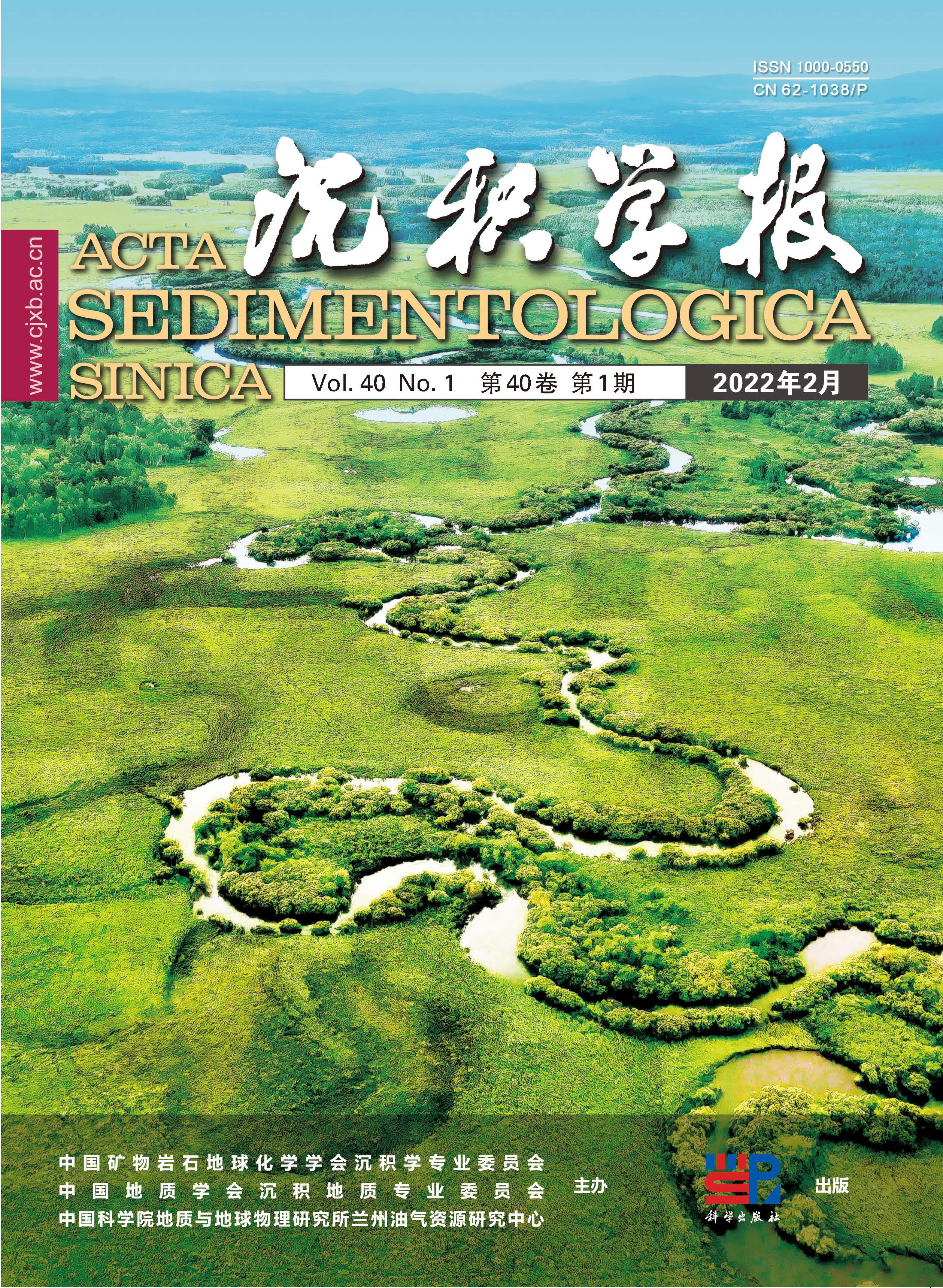


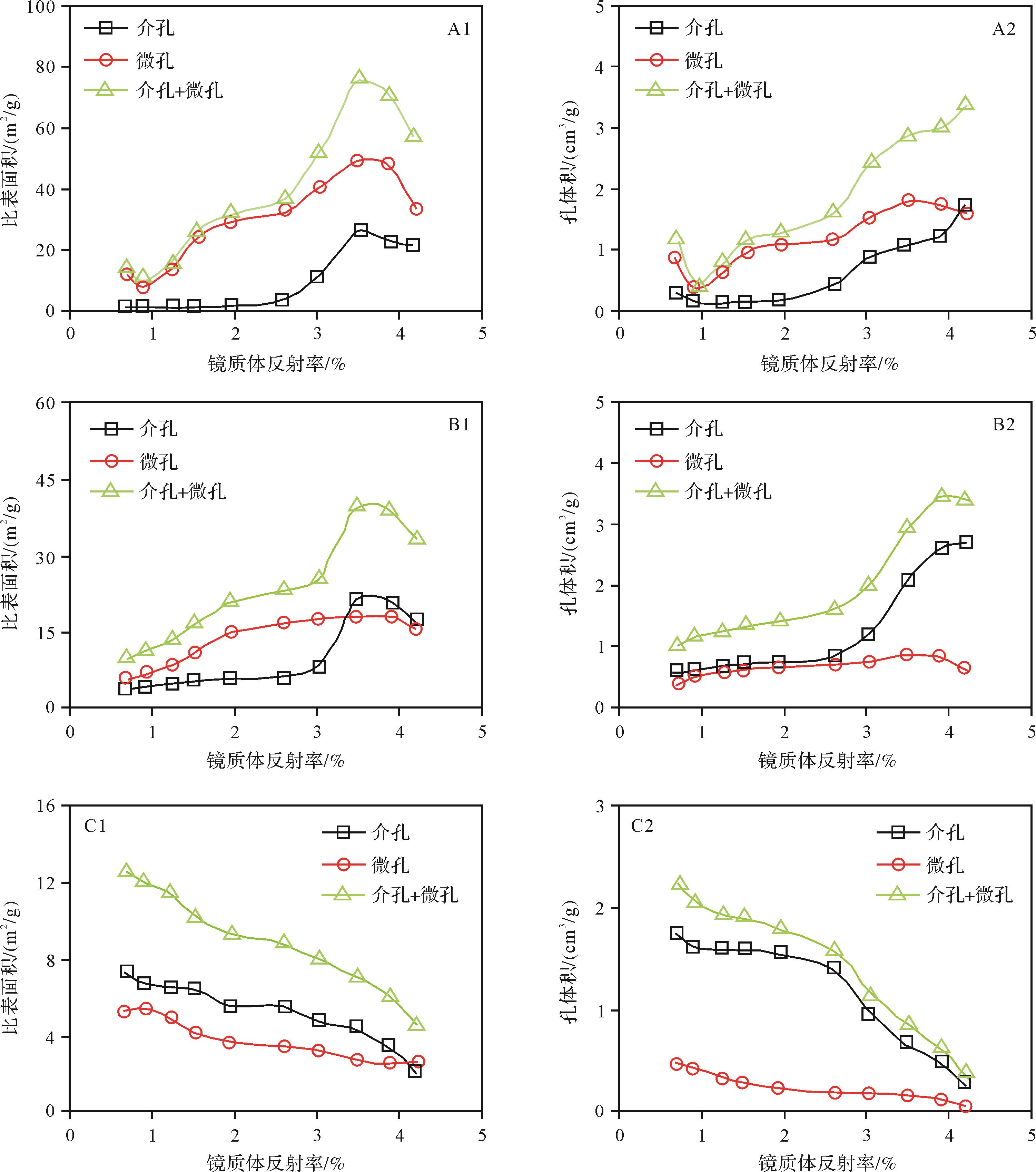


 DownLoad:
DownLoad:
